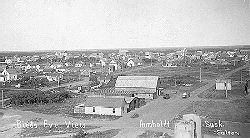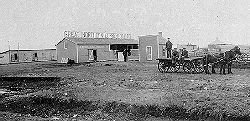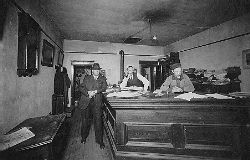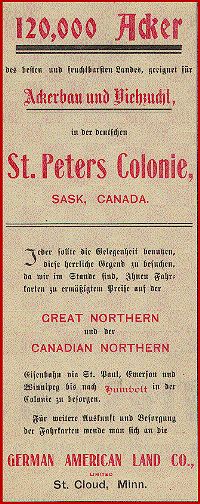
Full Size = 117K

"The Canadian Northern Railway, under construction, reached Humboldt in September, 1904. The first building was a log restaurant, which was built by Mr. Rath on the north side of the track. The chief part of the meal was rabbit, there being no other meat available. Among the first buildings erected here were the Depot and temporary housing quarters for the railroad employees and temporary roundhouse. Mr. John McTaggart from Winnipeg was early on the ground; being a relative of Sir William McKenzie, he was given preference in getting his material on the grounds for his hardware store. He carried a complete stock of hardware and later sold out to the Great Northern Lumber Company. This store was built before the town was surveyed. Mr. Henderson from Winnipeg was an early settler, establishing a lumber and hardware business. He built in the Northwest part of the town also before it was surveyed. This business was later sold to Messrs. Ritz and Yoerger."


"The first general merchants in town were the Great Northern Lumber Company carrying a stock of general merchandise, hardware and lumber. Their store, built on the south side of the track, was a tar papered building and was situated where the old fire hall stood. The fire hall was a frame structure, the front part used for the storage of the fire engine and hose and the back part for housing the pump. The well was a producer of good water and supplied the needs of the town, delivery being made to all."
"The first overseer was J. H. Lyons who was succeeded by J. W. Lowes, to whom great credit should be given for his work in getting the town established. It was during his term of office as overseer, that plans were made for the incorporation of the hamlet as a town. He ran for office of mayor but was defeated by a small margin by O. W. Andreasen who became the first mayor of Humboldt. During his term of office many local improvements were made, waterworks, electric lights and many miles of sidewalks. The town was organized into a school district in 1905, the first trustees being George Ritz, E. G. Walker and J. G. Yoerger. The first school teachers were Miss Alma Lyons and Miss Scanlan. There being no school building, classes were held in the Presbyterian church."
"The Presbyterian church was the first church established here in 1905 with Reverend Jos. Hunter as the missionary who came direct from Scotland. This church was later sold to the Salvation Army who are still carrying on in the same building."
"The next church to be established here was the Anglican, which was built close to where the Post Office now stands. This building was later moved to their own property and is still in use as a vestry."
"The Roman Catholic Church held their services in the Old Great Northern Store on the south side of the track. This building was later torn down and rebuilt near their present church on First Avenue and later used as a school."
"The pioneer settlers drove in from Rosthern and Saskatoon, before the railroad was built. They mostly lived in log shacks, a few had horses but most of them had oxen. They came to town over trails which wound around sloughs and bluffs. The trail to the south passed by George Barnes' place, by Mr. Kopp's and Joe Tholes' places and by the old telegraph station. The old station was a log building and was replaced by the building now on the site. The lumber and material used was freighted from Saskatoon. Mr. J. H. McDonald was the first operator. The Humboldt mail went by train to Rosthern and was brought by stage to Muenster from where it was brought to Humboldt every Saturday and distributed from the Great Northern Company store. Later the Post Office was established in Lowes' and Kepkey's General Store, Mr. Lowes being the postmaster."
"The first passenger train arrived in May, 1905, and created great excitement. We had mail and train service every second day. Before this the first settlers came on the caboose and work trains. The town's first celebration was held on 1st of July, 1905, with floats, horse racing, baseball and football. The town was nicely decorated for the occasion with flags and bunting and Dorothea Kepkey was Miss Humboldt. (Dorothea was the first child born in Humboldt)."
"The first fire was the Windsor Hotel which was burned while under construction. The building was up and a stairway in it was partly lathed. A strong wind was blowing, and it was thought that coal oil had been accidentally spilled which in some way became lighted. The flames and sparks and flaming shingles were carried south a distance of three miles. Several men escaping in their night clothes were quite badly burned and were given medical attention at Wallace's drug store by Dr. Neely and Mr. and Mrs. Wallace. One man and his dog were burned to death. Mr. Tom Kidd, who was working on his engine in the railway yards, was the first to discover the fire and give the alarm. The people of the south side, in the track of the wind, spent the night on their roofs, extinguishing sparks as they landed."
A business venture of considerable importance to the community was the establishment by R. A. Telfer of a printing business and the publishing of a newspaper, "The Humboldt Journal", the first issue bearing the date of the 19th of October, 1905. W. B. Telfer joined his brother in the firm in 1907. The policy of the publisher, as announced in the first issue, was the furthering of the interests of the town and district at all times, and this policy has been consistently followed during the long life of the Journal which has continued, under the same management, for forty eight years. This must be close to a record in the Provincial newspaper field, of which the Telfers may be justly proud. W. B. Telfer, better known as Bill, the junior of the original Telfer Bros., severed his connection with the business some years ago, and recently Mr. Walter Telfer, a son of R. A., joined the firm.
During all of this time, settlers continued to pour into the country, the peak being reached in about 1906. The numbers of Americans emigrating to Canada created some concern in certain quarters in the United States, which deplored the loss of so many of their most progressive farmers, together with their cash and equipment. This problem was the subject of an editorial in an American newspaper, "The Portland Oregonian", reprinted in the Humboldt Journal of the time. While containing a sour note on the loss of the citizens and wealth, this article also contains some very interesting remarks showing that at least one editor treated philosophically a situation about which nothing much could be done. It is here reproduced in full as follows:
"The exodus of American farmers to Canada continues to be a phenomenon of the first importance. More of them are crossing into Canada this fall than ever before and they are flocking thither from all parts of the country. Formerly, it was the Middle West alone, which thus lost the heart of its citizenship. Now all parts of the Union suffer alike. Besides the regret, we cannot help feeling over the migration of many thousands of excellent citizens to a country which is certainly foreign and which may become hostile, the matter has an economic side which causes some concern."
"The 70,000 farmers who will go to Canada this fall to live will take with them some 70,000,000 dollars in cash and effects. But, of course, the most serious loss is the men themselves and their families who have forsaken the land of the free and the home of the brave to dwell under the rule of a monarch. Why do they go? Naturally, the cheap and fertile land of Western Canada attracts them. Each immigrant goes with the reasonable expectation of bettering his fortune. Indeed, in a few years he may grow rich through the abundant crops he can raise, and the increase in land values. But perhaps this is not the sole reason for the astonishing migration. There is a common notion abroad that, in Canada, life and property are appreciably safer than they are here. Murders are not so frequent, and are more speedily and surely punished. Mobs and unwritten law are virtually unknown in Canada. Again, the law is a vastly more ascertainable entity there. Canada does not permit its judges to veto acts of the legislative body. When a statute has been enacted, it is known to be a law of the land, until it has been repealed. This naturally imparts to Canadian civilization a security and stability which we have not yet attained."

There are Humboldt Journal articles pertaining to this subject:
 Huge Land Deal Being Consummated
Huge Land Deal Being Consummated
 50,000 Acres Change Hands In Humboldt
50,000 Acres Change Hands In Humboldt
 Mennonites Purchase The Schnaufer Brothers Farms 2720 Acres
Mennonites Purchase The Schnaufer Brothers Farms 2720 Acres
[ Home ]
Please send comments to Carlton Trail REDA Inc.
![]()
[ The Humboldt Journal ]
[Early Humboldt]
[ St. Peter's Abbey | Agriculture | Communities ]
[ Present-day Humboldt and Surrounding Communities ]
[ Language ]
![]()